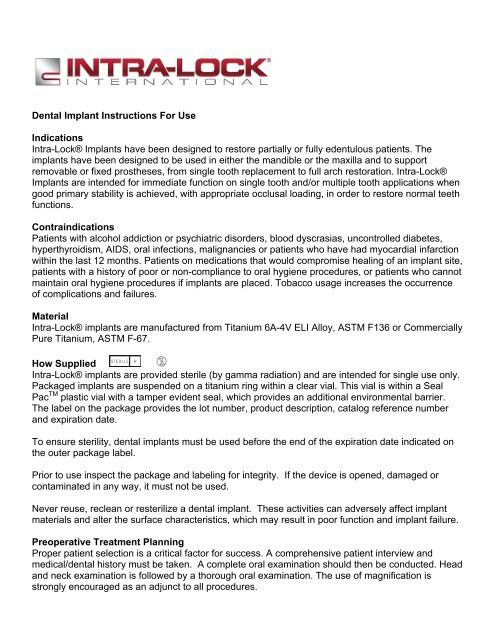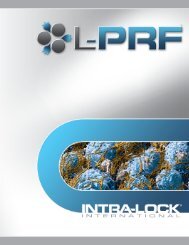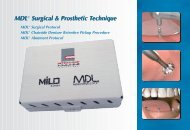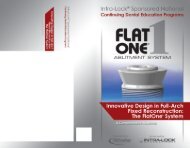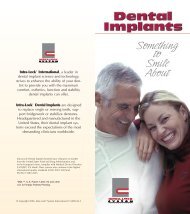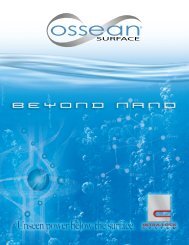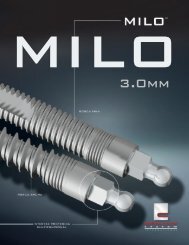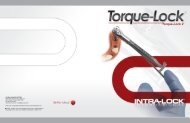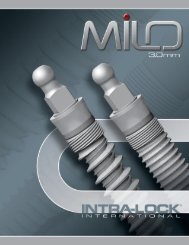Dental Implant Instructions For Use Indications Intra-Lock® Implants ...
Dental Implant Instructions For Use Indications Intra-Lock® Implants ...
Dental Implant Instructions For Use Indications Intra-Lock® Implants ...
Create successful ePaper yourself
Turn your PDF publications into a flip-book with our unique Google optimized e-Paper software.
<strong>Dental</strong> <strong>Implant</strong> <strong>Instructions</strong> <strong>For</strong> <strong>Use</strong><br />
<strong>Indications</strong><br />
<strong>Intra</strong>-<strong>Lock®</strong> <strong>Implant</strong>s have been designed to restore partially or fully edentulous patients. The<br />
implants have been designed to be used in either the mandible or the maxilla and to support<br />
removable or fixed prostheses, from single tooth replacement to full arch restoration. <strong>Intra</strong>-<strong>Lock®</strong><br />
<strong>Implant</strong>s are intended for immediate function on single tooth and/or multiple tooth applications when<br />
good primary stability is achieved, with appropriate occlusal loading, in order to restore normal teeth<br />
functions.<br />
Contraindications<br />
Patients with alcohol addiction or psychiatric disorders, blood dyscrasias, uncontrolled diabetes,<br />
hyperthyroidism, AIDS, oral infections, malignancies or patients who have had myocardial infarction<br />
within the last 12 months. Patients on medications that would compromise healing of an implant site,<br />
patients with a history of poor or non-compliance to oral hygiene procedures, or patients who cannot<br />
maintain oral hygiene procedures if implants are placed. Tobacco usage increases the occurrence<br />
of complications and failures.<br />
Material<br />
<strong>Intra</strong>-<strong>Lock®</strong> implants are manufactured from Titanium 6A-4V ELI Alloy, ASTM F136 or Commercially<br />
Pure Titanium, ASTM F-67.<br />
How Supplied<br />
<strong>Intra</strong>-<strong>Lock®</strong> implants are provided sterile (by gamma radiation) and are intended for single use only.<br />
Packaged implants are suspended on a titanium ring within a clear vial. This vial is within a Seal<br />
Pac TM plastic vial with a tamper evident seal, which provides an additional environmental barrier.<br />
The label on the package provides the lot number, product description, catalog reference number<br />
and expiration date.<br />
To ensure sterility, dental implants must be used before the end of the expiration date indicated on<br />
the outer package label.<br />
Prior to use inspect the package and labeling for integrity. If the device is opened, damaged or<br />
contaminated in any way, it must not be used.<br />
Never reuse, reclean or resterilize a dental implant. These activities can adversely affect implant<br />
materials and alter the surface characteristics, which may result in poor function and implant failure.<br />
Preoperative Treatment Planning<br />
Proper patient selection is a critical factor for success. A comprehensive patient interview and<br />
medical/dental history must be taken. A complete oral examination should then be conducted. Head<br />
and neck examination is followed by a thorough oral examination. The use of magnification is<br />
strongly encouraged as an adjunct to all procedures.
Oral inspection includes palpation and the proper radiographic protocol(s). This may include<br />
periapicals, panorex and tomograms. Palpation of the ridges is also required and the use of intraoral<br />
probes for tissue thickness is recommended.<br />
The diagnostic procedures will give the dentist an appreciation for the tissue quality and thickness,<br />
ridge morphology for the type and size of the implants that might be required. Measurements for<br />
implant size can be estimated utilizing radiographs, templates, calipers and millimeter rulers.<br />
Treatment planning should also take into consideration prosthetic biomechanics, occlusion and<br />
occlusal load. Fracture due to excessive load or metal fatigue can occur on the implant body or it’s<br />
prosthetic components if this aspect of planning is inadequate.<br />
Surgical Asepsis<br />
The operating field must be isolated with sterile coverings as much as possible. As with all surgical<br />
procedures, the operatory field should be maintained with sterile coverings (light handles, chair<br />
controls, bracket tray, and all instruments and components). Barrier technology, sterile solutions and<br />
sprays, sterile coverings, and proper autoclaving techniques must be employed as indicated.<br />
Sterilization of Abutments<br />
Abutments may be sterilized using a full cycle pre-vacuum steam sterilization at a temperature of<br />
132°C for an exposure time of 3 minutes.<br />
Precautions<br />
• Prosthetic components and drills may be autoclaved via standard procedures.<br />
• Handling: The external surface of titanium dental implants should only come in contact with<br />
titanium surfaced instruments. All implants are provided suspended on titanium rings and are<br />
designed for use with the Drive-Lock TM drivers.<br />
• This method will enable proper handling, transport and implantation procedures.<br />
Soft Tissue Site Preparation<br />
Once prepped (site isolation and local anesthesia achieved), the surgical procedure begins with<br />
identification of the implant site(s) via the creation of bleeding point(s). A mesio-distal incision is then<br />
made on the alveolar crest, extending approximately 3-5 mm beyond the implant site(s). It is<br />
imperative that a clear visual field be maintained at all times. The incision should penetrate to the<br />
full depth of the gingiva and the periosteum. A periosteal elevator is used to lift the periosteum and<br />
expose the alveolar bone.<br />
Any irregularities or deformities of the alveolar ridge should be eliminated or ameliorated at this time.<br />
The distance between implants and/or the natural dentition should be maintained within a range of<br />
4-6 mm.<br />
Penetration of the Alveolar ridge<br />
Of critical importance is the fact that all bone-cutting procedures are CONDUCTED AT SLOW<br />
SPEEDS (60-1200 RPM). Profuse, internal and/or external irrigation is also mandatory.
Drilling Technique<br />
The slow-speed, highly irrigated drilling procedure is conducted while angling the drill such that the<br />
direction of the drill bisects the ridge. The drill should also be held vertically, avoiding a mesial or<br />
distal cant. Depth gauge/alignment components can be periodically inserted into the osteotomy site<br />
to monitor the angle of penetration. Successively larger drills are used until the desired diameter is<br />
achieved. Drilling is performed with a precise, up and down pumping action. The drill angle is<br />
maintained in order to preserve the concentricity of the hole, while the pumping action allows for<br />
incremental depth penetration and periodic cleansing of the flutes.<br />
A Pilot Hole should be drilled where the bone is of high density. The “Lancer” Pilot drill is used for<br />
this procedure. It is recommended that the pilot hole extends to a depth of 8 mm.<br />
Drilling Sequence for Internal Connection <strong>Implant</strong>s<br />
1. Lancer Pilot Drill<br />
2. 1.5mm Drill<br />
3. 2.0mm Drill<br />
4. 2.5mm Drill<br />
5. Depending on implant diameter- 2.8mm, 3.2mm, 3.5mm, 4.2mm, 5.5mm Drills<br />
6. Final CD Drills match length of Tapered Body <strong>Implant</strong>s<br />
In more porous bone, in the maxilla, it is possible to use the final recommended drill to only half the<br />
implant length in order to increase primary stability.<br />
Completion of Site Preparation<br />
The implant site is periodically flushed and checked for proper depth. The drills have depth<br />
markings and a paralleling pin/depth gauge indicator is also available. The paralleling pins are<br />
utilized when multiple implant sites are prepared. As each site is completed, a paralleling pin can be<br />
inserted into the osteotomy site and used as a guide for the preparation of the next site.<br />
<strong>Implant</strong> Installation using the Drive-Lock TM<br />
The implants are suspended on a titanium ring, in order to enable direct transfer to the surgical site.<br />
(Picture1). The Drive-Lock TM carrier/placement driver is used to pick up the implant directly from the<br />
vial, carry it to the osteotomy site and thread the implant into place (Pictures 2, 3 & 4). This driver<br />
fits either contra angle or ratchet drives and can safely exert the necessary driving force without risk<br />
of deformation of the prosthetic interface connection.
The final seating of the implant(s) is achieved by the incremental turns of the Ratchet Wrench.<br />
Should bone density demand, the osteotomy site should be further prepared via the utilization of the<br />
Bone Tap. A Countersink Drill is also available for those clinicians choosing the option of exercising<br />
a countersink technique.<br />
The tip of the Drive-Lock TM (either for contra-angle or ratchet) is a 1.3 mm hex driver, designed to<br />
carry the cover screw onto the implant, once inserted into the osteotomy site (Picture 5).<br />
Radiographic Verification<br />
At this point, take the appropriate radiograph(s) to confirm proper depth, seating, orientation and<br />
placement of the implant(s).<br />
Placement of the Healing Screw<br />
After radiographic verification, a healing screw is then placed. The tip of the Drive-Lock TM ‚ (either for<br />
contra-angle or ratchet) is a 1.3 mm hex driver, designed to carry the cover screw onto the implant<br />
and thread it into place.<br />
Site Closure<br />
Irrigate the site for the final time, approximate the flaps and secure with interrupted mattress sutures<br />
or suture method of choice. It is important that maximum tissue adaptation be obtained.<br />
Important Points to Remember<br />
• Only titanium instruments should come in contact with the implant.<br />
• The Conic <strong>Implant</strong>s are designed to fit the drilled depth.<br />
• If a removable prosthesis is used near the implant site, it should be generously relieved and a soft<br />
tissue conditioner reline material placed.<br />
Postoperative Care<br />
Cold packs are recommended for the first 24 hours. Analgesics/Antibiotics may be prescribed at the<br />
discretion of the practitioner. The patient is advised to favor the opposite side of the mouth, maintain<br />
a soft diet and avoid hot liquids. Sutures may be removed after 5-7 days.<br />
Warning<br />
1<br />
2<br />
• <strong>Dental</strong> implant surgery is a complex dental procedure.<br />
• Appropriate and adequate training in all phases of implant procedures<br />
and proper technique is strongly recommended prior to implant use.<br />
• Improper patient selection, diagnosis, treatment planning or technique<br />
can result in implant failure and/or loss of supportive bone.<br />
• The use of small diameter implants and angled abutments in the<br />
posterior region of the mouth is not recommended due to possible failure<br />
of the implant.
Note: The <strong>Intra</strong>-<strong>Lock®</strong> <strong>Dental</strong> <strong>Implant</strong> System has not been evaluated for safety and compatibility in<br />
the MR environment. The <strong>Intra</strong>-<strong>Lock®</strong> <strong>Dental</strong> <strong>Implant</strong> System has not been tested for heating or<br />
migration in the MR environment.<br />
<strong>Intra</strong>-Lock International Inc.<br />
6560 West Rogers Circle<br />
Boca Raton FL 33487 - USA<br />
www.intra-lock.com<br />
<strong>Intra</strong>-Lock System Europa, Spa<br />
I-84100 Salerno<br />
0499<br />
S40-02-01 (05/11)


